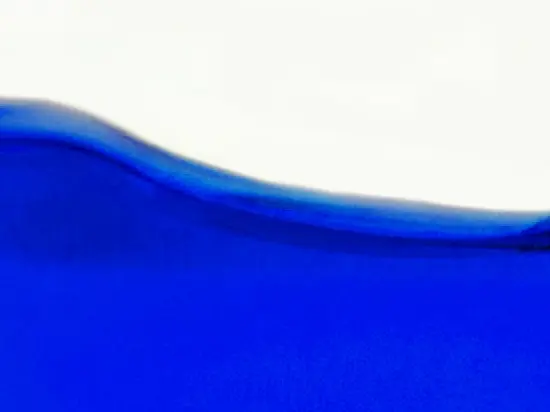
Spirulina Blue (Phycocyanin)
- Phycocyanin 1g/1000mL
- Tincture
On Request weeks

Why is the blue spirulina important?
Blue spirulina extract phycocyanin is a powerful antioxidant[2, 3, 5] and can be used in many ways as a blue colorant. Both in cosmetics and in food.
Typical applications: Spirulina Blue (Phycocyanin)
The blue spirulina dye phycocyanin is a natural food colouring. It is a healthy protein with many amino acids and can be used in various products. Especially in colored sweets, phycocyanin is a unique, natural color for blue.
The company Haribo offered blue jelly babies as a short-term offer in the Fan Edition. The blue eye-catchers were coloured with the natural colouring agent phycocyanin from spirulina.
Typical applications
- Phycocyanin is used as a dietary supplement, or coloring ingredient in various foods e.g. candies and gummy animals
- In cosmetics, phycocyanin is added because its anti-inflammatory[2, 3, 5] properties promote a healthy skin appearance
- As a dietary supplement, it is often offered as a liquid phycocyanin shot to increase performance
Typical applications in the cosmetics industry:
The liquid form of phycocyanin is marketed as the original product of unparalleled purity. Phycocyanin is the famous blue pigment of Spirulina algae. The natural, water-soluble antioxidant[2, 3, 5] has an intense blue color, which is popularly used in cosmetics as a coloring and functional component. Thus, the substance contained in spirulina determines a long-lasting green-blue coloration in cosmetic formulas such as lotions.
Due to its antioxidant[2, 3, 5] potential, it is an effective radical fighter.
In addition, various studies show that phycocyanin has anti-inflammatory[2, 3, 5] properties and promotes healthy skin appearance.

ALGANEX certificate system
- ALGANEX guarantees a high quality product without impurities
Product information: Spirulina Blue (Phycocyanin)
Phycocyanin is formed by the microalgae Spirulina and is a natural, water-soluble antioxidant[2, 3, 5] with an intense blue colour. Various studies have demonstrated anti-inflammatory properties[2, 3, 5]. Due to its antioxidative potential it is also an effective radical scavenger.
Sources:
- Phycocyanin - Wikipedia (https://en.wikipedia.org/wiki/Phycocyanin)
- Blas-Valdivia V, Moran-Dorantes DN, Rojas-Franco P, Franco-Colin M, Mirhosseini N, Davarnejad R, Halajisani A, Tavakoli O, Cano-Europa E. C-Phycocyanin prevents acute myocardial infarction-induced oxidative stress, inflammation and cardiac damage. Pharm Biol. 2022 Dec;60(1):755-763. doi: 10.1080/13880209.2022.2055089. PMID: 35373708; PMCID: PMC8979534. (https://pubmed.ncbi.nlm.nih.gov/35373708/)
- Motamedzadeh A, Rahmati-Dehkordi F, Heydari H, Behnam M, Rashidi Noshabad FZ, Tamtaji Z, Taheri AT, Nabavizadeh F, Aschner M, Mirzaei H, Tamtaji OR. Therapeutic potential of Phycocyanin in gastrointestinal cancers and related disorders. Mol Biol Rep. 2024 Jun 14;51(1):741. doi: 10.1007/s11033-024-09675-3. PMID: 38874869. (https://pubmed.ncbi.nlm.nih.gov/38874869/)
- Ashaolu TJ, Samborska K, Lee CC, Tomas M, Capanoglu E, Tarhan Ö, Taze B, Jafari SM. Phycocyanin, a super functional ingredient from algae; properties, purification characterization, and applications. Int J Biol Macromol. 2021 Dec 15;193(Pt B):2320-2331. doi: 10.1016/j.ijbiomac.2021.11.064. Epub 2021 Nov 16. PMID: 34793814. (https://pubmed.ncbi.nlm.nih.gov/34793814/)
- Bannu SM, Lomada D, Gulla S, Chandrasekhar T, Reddanna P, Reddy MC. Potential Therapeutic Applications of C-Phycocyanin. Curr Drug Metab. 2019;20(12):967-976. doi: 10.2174/1389200220666191127110857. PMID: 31775595. (https://pubmed.ncbi.nlm.nih.gov/31775595/)
- Liu R, Qin S, Li W. Phycocyanin: Anti-inflammatory effect and mechanism. Biomed Pharmacother. 2022 Sep;153:113362. doi: 10.1016/j.biopha.2022.113362. Epub 2022 Jul 14. PMID: 36076518. (https://pubmed.ncbi.nlm.nih.gov/36076518/)
- Xu FH, Qiu YZ, Zhang Y, Yang FH, Ji MM, Liu KC, Jin M, Zhang SS, Li B. The molecular mechanism of three novel peptides from C-phycocyanin alleviates MPTP-induced Parkinson's disease-like pathology in zebrafish. Food Funct. 2023 Jul 3;14(13):6157-6171. doi: 10.1039/d3fo01098h. PMID: 37337786. (https://pubmed.ncbi.nlm.nih.gov/37337786/)
- Kumari RP, Anbarasu K. Protective role of C-phycocyanin against secondary changes during sodium selenite mediated cataractogenesis. Nat Prod Bioprospect. 2014 Apr;4(2):81-9. doi: 10.1007/s13659-014-0008-4. Epub 2014 Apr 2. PMID: 24858035; PMCID: PMC4004860. (https://pubmed.ncbi.nlm.nih.gov/24858035/)
- Fernandes R, Campos J, Serra M, Fidalgo J, Almeida H, Casas A, Toubarro D, Barros AIRNA. Exploring the Benefits of Phycocyanin: From Spirulina Cultivation to Its Widespread Applications. Pharmaceuticals (Basel). 2023 Apr 14;16(4):592. doi: 10.3390/ph16040592. PMID: 37111349; PMCID: PMC10144176. (https://pubmed.ncbi.nlm.nih.gov/37111349/)
- Romay Ch, González R, Ledón N, Remirez D, Rimbau V. C-phycocyanin: a biliprotein with antioxidant, anti-inflammatory and neuroprotective effects. Curr Protein Pept Sci. 2003 Jun;4(3):207-16. doi: 10.2174/1389203033487216. PMID: 12769719. (https://pubmed.ncbi.nlm.nih.gov/12769719/)
- Romay C, Armesto J, Remirez D, González R, Ledon N, García I. Antioxidant and anti-inflammatory properties of C-phycocyanin from blue-green algae. Inflamm Res. 1998 Jan;47(1):36-41. doi: 10.1007/s000110050256. PMID: 9495584. (https://pubmed.ncbi.nlm.nih.gov/9495584/)
- Li B, Chu X, Gao M, Li W. Apoptotic mechanism of MCF-7 breast cells in vivo and in vitro induced by photodynamic therapy with C-phycocyanin. Acta Biochim Biophys Sin (Shanghai). 2010 Jan;42(1):80-9. doi: 10.1093/abbs/gmp104. PMID: 20043050. (https://pubmed.ncbi.nlm.nih.gov/20043050/)
- Gigova, Liliana. (2014). Gardeva E, Toshkova R, Yossifova L, Minkova K, Ivanova N, Gigova* L. Antitumor activity of C-Phycocyanin from Arthronema africanum (Cyanophyceae). Braz. Arch. Biol. Technol. 2014, 57(5):675-684. ISSN: 1678-4324. (IF2011 - 0.551). (https://www.researchgate.net/publication/270895963)
Reply within twelve hours